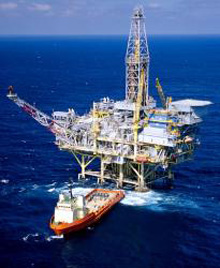
By Greg Boland, Biological Oceanographer - Bureau of Ocean Energy Management

Industry inspection video images of corals on the Pompano platform in 2008 at depths of over 300 m. The first observation of Lophelia coral on deep-water Gulf of Mexico platforms was on this same structure in 2003 during a NOAA OER mission. Image courtesy of the Bureau of Ocean Energy Management (BOEM). Download larger version (jpg, 600 KB).
This Lophelia II 2012: Deepwater Platform Corals mission is the final cruise of a study sponsored by the National Oceanographic Partnership Program (NOPP). Numerous cooperating groups and leading scientists were brought together to explore and study poorly understood deep-water, or “cold-water”, coral communities and shipwrecks in the deep Gulf of Mexico (GOM). The interagency partnership between the Bureau of Ocean Energy Management (BOEM) and National Oceanic and Atmospheric Administration’s Office of Ocean Exploration and Research (NOAA OER) included additional partnering with the U.S. Geological Survey (USGS) and university scientists to conduct exploration and science discovery in water depths ranging from 1,000 to 9,000 feet.
The development of oil and gas resources has been identified as a potential threat to deep-sea coral habitats. In 2011, 480 million barrels of oil and 1.8 trillion cubic feet of natural gas were produced in the GOM. BOEM’s mission is to manage the exploration and development of the offshore energy and marine mineral resources on the 1.76-billion acres of the U.S. Outer Continental Shelf (OCS), while protecting the human, marine, and coastal environments. The oil and gas industry has moved, and will continue to move, into deeper and deeper water in their continuing search for energy reserves. Current capabilities allow energy production in water depths up to 10,000 ft.

Surface view of the Pompano platform which is a solid bottom-founded structure in a water depth of 595 m. Image courtesy of the Bureau of Ocean Energy Management (BOEM). Download image (jpg, 30 KB).
This project includes exploration and research at three different kinds of deepwater habitat; natural reefs, shipwrecks and offshore energy platforms. This fifth and final cruise of the study is focusing on the third environment, offshore energy platforms. In addition to scientific and management goals, a major component of the project has included educational outreach to allow the general public and especially children to experience and learn about these unique features and ecosystems. Partnering included three government agencies, eleven private companies including eight offshore energy companies, and five universities.
During previous expeditions, scientists conducted extensive research on both natural habitats and shipwrecks. These cruises are detailed on previous expedition sites at:
Lophelia II 2008: Deepwater Coral Expedition: Reefs, Rigs, and Wrecks
Lophelia II 2009: Deepwater Coral Expedition: Reefs, Rigs, and Wrecks
Lophelia II 2010: Oil Seeps and Deep Reefs
The shipwreck component of the study made many significant discoveries; one wreck investigated was at a depth of over 2,140 m, the deepest investigation of its kind in the GOM. Several of the wrecks had extensive communities of deep-water corals. Unique artifacts were recovered that will be preserved and eventually put on display for the education and enjoyment of the public.
BOEM has been active in the role of deepwater coral research in the GOM for over 10 years with a history of successful adaptive management of these sensitive habitats using science derived from their funding of a series of large applied-science studies and the application of study results to regulatory policy. The first dedicated deepwater coral study in the Gulf of Mexico, Characterization of Northern Gulf of Mexico Deepwater Hard Bottom Communities with Emphasis on Lophelia Coral was an important step in gaining knowledge of previously unknown sensitive biological habitats in the deep GOM. The resulting final report is available on the BOEM Web site as report MMS 2007-044 .
In addition to scientific discoveries that have increased our understanding of the poorly known deep-water corals and the communities of animals they support, the project has already had tangible impacts on management of deepwater natural resources. Specifically, a BOEM regulatory policy termed “Notice to Lessees” was revised as a direct application of this partnership-based science. This included raising the minimum water depth requiring review for all energy development activity and increasing the avoidance buffer distances required for separation from drilling discharges and other physical impacts such as anchoring from potential deep coral community locations.
This Lophelia II cruise team will be visiting between six and nine deepwater production platforms and will represent the first dedicated scientific study of deep-sea corals on actively producing oil and gas platforms. Detailed imaging and collections of coral specimens will provide important growth rate and genetic information necessary to understand the distribution and genetic connections of deepwater coral populations in the Gulf of Mexico. Results from this mission will also provide an understanding of how deepwater structures serve as artificial reefs and will contribute to future decisions on how these deepwater structures are managed on the Outer Continental Shelf. Overall, the results from this study will provide the scientific basis to further refine current protective measures for oil and gas operations and the need for avoidance of sensitive biological communities in deepwater.